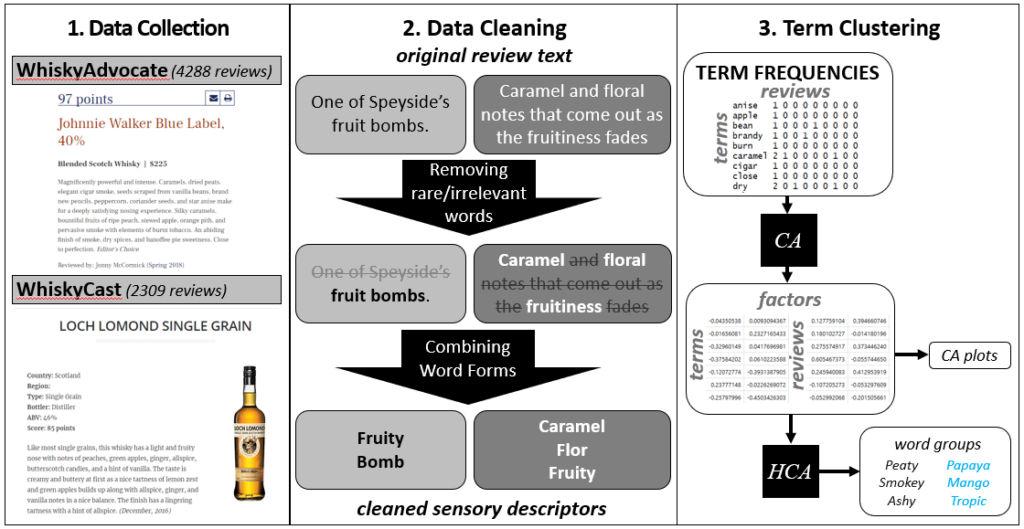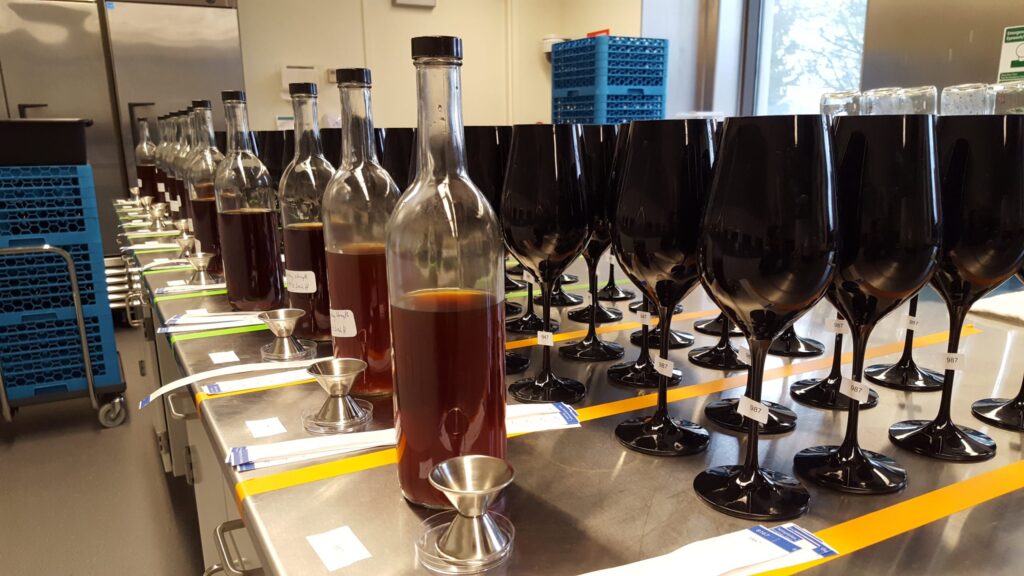Using Natural Language Food Descriptions as Data

In all parts of the food industry, high-quality data about flavor are needed to determine the influence of formulation or process changes on a product, to assess a product’s uniqueness relative to competitors, and to supplement consumer preference data so beneficial changes can be identified. While flavor is caused by components in food activating human sensory receptors, it is difficult to measure the entire spectrum of flavor compounds at once, and equally if not more difficult to relate these measurements to the final flavor perception by consumers. Thus, human identification and quantification of relevant flavor attributes is often the most direct method of collecting flavor data, and any methods which make collection or analysis of these sensory data easier or faster have the potential to allow for faster, more informed decisions about food quality. As language is the method human tasters are generally most comfortable using to communicate their experiences and sensations, Natural Language Processing methods (which allow for the systematic analysis of large amounts of language data) are a natural fit for rapid sensory evaluation methods.
Selected Publications
- Hamilton, L. M., & Lahne, J. (2023). Chapter 16 ‑ Natural Language Processing. In J. Delarue & J. B. Lawlor (Eds.), Rapid Sensory Profiling Techniques (Second Edition) (Second Edition, pp. 371–410). Woodhead Publishing. https://doi.org/10.1016/B978-0-12-821936-2.00004-2
- Hamilton, L. M., Neill, C. L., & Lahne, J. (2023). Flavor language in expert reviews versus consumer preferences: An application to expensive American whiskeys. Food Quality and Preference, 109. https://doi.org/10.1016/j.foodqual.2023.104892
- Miller, C., Hamilton, L. M., & Lahne, J. (2021). Sensory Descriptor Analysis of Whisky Lexicons through the Use of Deep Learning. Foods, 10(7), 1633. https://doi.org/10.3390/foods10071633
- Hamilton, L. M., & Lahne, J. (2020). Fast and automated sensory analysis: Using natural language processing for descriptive lexicon development. Food Quality and Preference, 83(February), 103926. https://doi.org/10.1016/j.foodqual.2020.103926
Understanding Novel Products

Sensory scientists are increasingly relying on “rapid” sensory methods to understand new product categories as they’re taking off, whether that be slight variations on familiar products like cold brew coffee, traditional products like hard cider that have been under-studied relative to similar categories, or brand new concepts like hop water. I’m very interested in how people make sense of these products, where they fit them into their lives, and what they see them as “alternatives” to, which is increasingly common marketing parlance. This usually requires rapid sensory testing and often dovetails into my work with natural language processing methods, as natural language data are generally easy to collect and don’t require that the tasters or researchers have a predetermined lexicon to communicate.
Feel free to bring me your questions about DISTATIS for sorting data and Correspondence Analysis and other text analyses for free comment data.
Selected Publications
- Hamilton, L. M., & Delarue, J. (2024). Alternative drinks: Understanding perceptions of a novel drink category using open‑ended surveys in simulated drinking contexts. Science Talks, 11, 100372. https://doi.org/10.1016/j.sctalk.2024.100372
- Hamilton, LM and Lahne, J. (2020). Assessment of instructions on panelist cognitive framework and free sorting task results: A case study of cold brew coffee. Food Quality and Preference, 83. doi:10.1016/j.foodqual.2020.103889
Flavor and Off-Flavor Development in Fermented Products
Microbial metabolites are responsible for the flavor of many foods we all care about made at all scales. Across the food industry, the ability of fermentative microbes to create wildly different flavors based on the fermentation conditions is highly praised and highly maligned. With increasing interest in wild-type fermentations and local, small-scale production, there is increasing need for methods to understand and explore the complex relationships between microbes, environments, foods, and the senses.
As both a flavor chemist and a sensory scientist, I’ve worked mostly with industrial production of fermented foods and beverages, but I’m increasingly interested in better understanding what home picklers, brewers, and other kinds of fermentation aficionados are making, what microbes they’re cultivating, and how this affects flavor. I’m particularly interested in what these makers already know about the flavors of their products and where they feel there are gaps in their knowledge.
Selected Publications
- Hamilton, LM and Lahne, J. Fast and automated sensory analysis: Using natural language processing for descriptive lexicon development. 2020. Food Quality and Preference, 83. doi:10.1016/j.foodqual.2020.103926
- Cairns, P, Lahne, J, Gallagher, D, Hamilton, LM, Racine, K, Phetxumphou, K, Ma, S, Huang, H, and Stewart, AC. Effects of Hydroxycinnmates and Exogenous Yeast Assimilable Nitrogen on Cider Aroma and Fermentation Performance. 2021. Journal of the American Society of Brewing Chemists. doi:10.1080/03610470.2021.1968171
- Hamilton, LM, Johanningsmeier, S, Rosenberg, L, and Wilson, E. Novel Oxidation Products in Cucumber Pickles in Real Time and Accelerated Shelf-Life Environments. 2019. Poster session presented at IFT19, New Orleans, LA.
